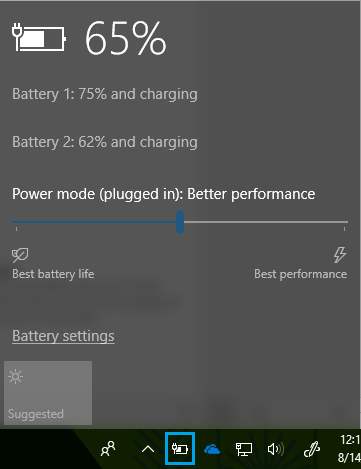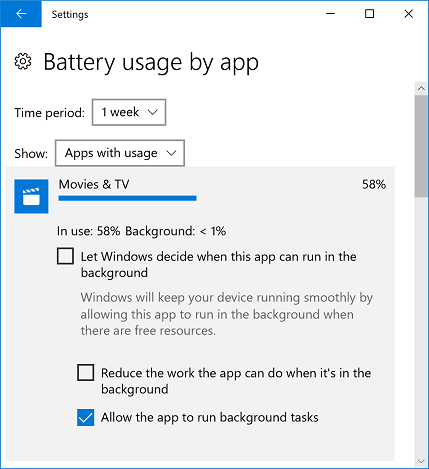Training
Learning path
Use advance techniques in canvas apps to perform custom updates and optimization - Training
Use advance techniques in canvas apps to perform custom updates and optimization
This browser is no longer supported.
Upgrade to Microsoft Edge to take advantage of the latest features, security updates, and technical support.
The Windows performance power slider enables end customers to quickly and intelligently trade performance of their system for longer battery life. As a customer switches between the four slider modes to trade performance for battery life (or vice versa), Windows power settings are engaged behind the scenes. You are able to customize the default slider mode for both AC and DC, and can also configure the power settings, and PPM options, that are engaged for each slider mode.
Customers can access the slider on their Windows device by clicking or tapping the battery icon in the task bar. The slider appears in the battery flyout.

Customers can choose their power mode by moving the slider to the left and right. Customers can choose to prioritize the remaining battery life on the device, or the performance of apps and services running on the device. The screenshot above shows the slider is in the Better Performance slider mode, which is the out-of-box Windows default.
The slider will appear on a device only when the Balanced power plan, or any plan that is derived from Balanced, is selected. There is not an option for either users or OEMs to remove the slider UX.
Devices that have the High Performance, Power Saver, or any "OEM Recommended" power plans will not be disturbed during the Windows upgrade process. If a user upgrades from a version of Windows that does not support the slider, to a version that does, there will be no change to their High Performance, Power Saver, or "OEM Recommended" power plan. These users will not see the slider UX, and they can still configure their power plans in the same way they could before upgrading.
Users will see the power slider appear only when they apply the Balanced power plan from the Settings app, under System > Power & Sleep > Additional power settings.
Note
After the user changes to a Balanced performance plan, there is no way for them to go back to using the High Performance plan from the UI, although it is possible from the cmd line (via powercfg).
If you ship a device with a High Performance power plan, such as a gaming device, consider applying the same settings that are defined on the High Performance plan to the Balanced power plan. For example, if the timeout value for powering off the HDD or Display is set to X or Y on High Performance, apply those same values on Balanced.
You can also customize power settings for each of the slider modes in your firmware. See Configure power settings and PPM options for more information.
Customers can choose one of four slider modes:
Note
Game mode operates independently of the Windows performance power slider, and can be engaged in any slider mode.
You can configure the default slider mode for both AC and DC. If a customer chooses a different slider mode on either AC or DC, their selection will become the new default setting.
Note
Battery Saver is not available as a default slider mode.
First, create a provisioning package using Windows Configuration Designer. You will then edit the customizations.xml file contained in the package to include your power settings. Use the XML file as one of the inputs to the Windows Configuration Designer command-line to generate a provisioning package that contains the power settings, then apply the package to the image. For information on how to use the Windows Configuration Designer CLI, see Use the Windows Configuration Designer command-line interface.
| Windows Provisioning path | Provisioning setting name | Values |
|---|---|---|
Common\Power\Controls\Settings\{setting name} |
DefaultOverlayAcPowerScheme: Default slider mode for AC DefaultOverlayDcPowerScheme: Default slider mode for DC |
961cc777-2547-4f9d-8174-7d86181b8a7a: Sets the slider to the Better Battery mode 3af9B8d9-7c97-431d-ad78-34a8bfea439f: Sets the slider to the Better Performance mode ded574b5-45a0-4f42-8737-46345c09c238: Sets the slider to the Best Performance mode |
Note
If no default is configured, Better Performance will be the default slider mode for both AC and DC.
Below is an example customizations.xml file that defines default slider modes.
<?xml version="1.0" encoding="utf-8"?>
<WindowsCustomizatons>
<PackageConfig xmlns="urn:schemas-Microsoft-com:Windows-ICD-Package-Config.v1.0">
<ID>{7e5c6cb3-bd16-4c1a-aacb-98c9151d5f20}</ID> <!-- ID needs to be unique GUID for the package -->
<Name>CustomOEM.Power.Settings.Control</Name>
<Version>1.0</Version>
<OwnerType>OEM</OwnerType>
</PackageConfig>
<Settings xmlns="urn:schemas-microsoft-com:windows-provisioning">
<Customizations>
<Common>
<Power>
<Controls>
<DefaultOverlayDcPowerScheme>961cc777-2547-4f9d-8174-7d86181b8a7a</DefaultOverlayDcPowerScheme>
<DefaultOverlayAcPowerScheme>ded574b5-45a0-4f42-8737-46345c09c238</DefaultOverlayAcPowerScheme>
</Controls>
</Power>
</Common>
</Customizations>
</Settings>
</WindowsCustomizatons>
You can use overlays to customize the power settings and PPM options that are engaged for each slider mode. In previous versions of Windows, power settings could only be configured per power scheme, and PPM options could only be configured per power profile. The introduction of overlays enables OEMs to better optimize power settings based on the slider mode selected by the user, as opposed to the power scheme or power profile selected by the device.
To configure PPM and power settings per slider mode, apply them to one of the following overlays:
The Battery Saver mode inherits the settings configured for the Constrained PPM profile (in the ppkg, Setting ProfileAlias should be "Constrained"). The Best Performance mode inherits the settings configured for the Balanced (default) profile. Configure these profiles to customize the settings that are engaged in the associated slider modes. Note that in the ppkg, the Profile SchemeAlias should be "Balanced".
Note
Settings such as disk and display timeouts, and other legacy power settings, are not customizable via the performance/power slider. Only settings which can affect perceived performance differences can be customized across slider modes. Each slider mode should be thought of as a "lite" power plan, which only contains settings that impact performance, such as CPU settings (PPM) and power throttling. Other factors which control performance (GPU, thermals etc) are in OEM/SVs control and they can create custom power-settings for those and connect them to the slider via the INF.
Optimizing PPM enables the OS to favor either power or performance, depending on user preference (similar to the low power media profile that is applied when a user is watching video in full screen mode). PPM settings should favor battery life for the Battery Saver and Better Battery slider modes, and favor performance for the Better and Best Performance slider modes.
PPM options can be configured for all AMD and Intel platforms using Windows Provisioning Framework. To learn more about the PPM options that you can configure, and how to configure them per power scheme, see Processor power management options.
Below is an example of a customizations.xml file that uses overlays to define PPM settings for the Better Battery and Best Performance slider modes.
<Power>
<Policy>
<Settings>
<Processor>
<SchemePersonality>
<!-- EPP override for default PPM profile for "Better Battery" -->
<Profile SchemeAlias="BetterBatteryLifeOverlay">
<Setting ProfileAlias="Default">
<PerfEnergyPreference>
<DcValue>60</DcValue>
</PerfEnergyPreference>
</Setting>
</Profile>
<!--EPP override for default PPM profile for "Best Performance" -->
<Profile SchemeAlias="MaxPerformanceOverlay">
<Setting ProfileAlias="Default">
<PerfEnergyPreference>
<DcValue>30</DcValue>
</PerfEnergyPreference>
</Setting>
</Profile>
</SchemePersonality>
</Processor>
</Settings>
</Policy>
</Power>
To engage your customized power settings only when the slider is in a particular mode, create an AddPowerSettingDirective in your INF file that indicates the default values for each overlay. There are Default directives that must be included in an AddPowerSetting section. A Default directive specifies the three overlays that apply to an AC and DC power state each.
Add the following three directives to define settings for the various slider modes:
| Slider mode | INF GUID | Ppkg SchemeAlias |
|---|---|---|
| Better Battery | {961CC777-2547-4F9D-8174-7D86181b8A7A} | BetterBatteryLifeOverlay |
| Better Performance | {381B4222-F694-41F0-9685-FF5BB260DF2E} | Balanced |
| Best Performance | {DED574B5-45A0-4F42-8737-46345C09C238} | MaxPerformanceOverlay |
See INF AddPowerSetting Directive for further instructions.
You can also listen to changes in slider position via the Effective Power Mode API.
Starting with Windows release 1903 the slider is available for AC only (i.e. non-battery powered) devices as an OEM opt-in feature. OEM's can define power/performance settings for the 'better battery' and 'max performance' overlays via a provisioning package to enable it for these devices. There are no any inbox defaults associated with the slider for AC only devices, only the below defined settings will be modified as slider position changes. Once deployed it'll will show up under the 'Power and Sleep' page accessible via the inbox settings app.
Below is an example of a customizations.xml file that uses overlays to define PPM settings for the Better Battery and Best Performance slider modes.
Note
The slider will appear on a device only when the Balanced power plan, or any plan that is derived from Balanced is selected.
<Power>
<Policy>
<Settings>
<Processor>
<SchemePersonality>
<!-- EPP override for default PPM profile for "Better Battery" -->
<Profile SchemeAlias="BetterBatteryLifeOverlay">
<Setting ProfileAlias="Default">
<PerfEnergyPreference>
<AcValue>60</AcValue>
</PerfEnergyPreference>
</Setting>
</Profile>
<!--EPP override for default PPM profile for "Best Performance" -->
<Profile SchemeAlias="MaxPerformanceOverlay">
<Setting ProfileAlias="Default">
<PerfEnergyPreference>
<AcValue>30</AcValue>
</PerfEnergyPreference>
</Setting>
</Profile>
</SchemePersonality>
</Processor>
</Settings>
</Policy>
</Power>
Most Windows users have multiple apps running on the operating system at the same time, and often, the apps running in the background consume significant power. Windows leverages modern silicon capabilities to run background work in an energy-efficient manner, significantly enhancing battery life. Power throttling saves up to 11% in CPU power by throttling CPU frequency of applications running in the background. With power throttling, when background work is running, Windows places the CPU in its most efficient operating modes. Learn more about this feature in our blog post: Introducing power throttling.
Power throttling does not suspend or close apps and services on the device.
Power throttling is always engaged, unless the slider is set to Best Performance. In this case, all applications will be opted out of power throttling. Users can also opt individual apps out of power throttling in the Battery usage UX:

OEMs do not have an option to disable or change power throttling on any of the Windows slider modes.
Note
Power throttling is available for devices using Intel's 6th or 7th generation processors (including those without Intel's SpeedShift technology) only.
There are two logs you can utilize to query the performance power slider settings defined on an OS image: Powercfg output, and Event Tracing for Windows (ETW) logs.
Run "powercfg /qh > output.txt" from an elevated command prompt, then open output.txt in any text editor to view the settings.
Use the inbox WPRUI.exe or WPR.exe to collect an ETW log with the POWER scenario enabled. To collect and analyze the ETW log:
WPR -start power -filemodeWPR -stop PerfPowerSliderSettings.etlTraining
Learning path
Use advance techniques in canvas apps to perform custom updates and optimization - Training
Use advance techniques in canvas apps to perform custom updates and optimization